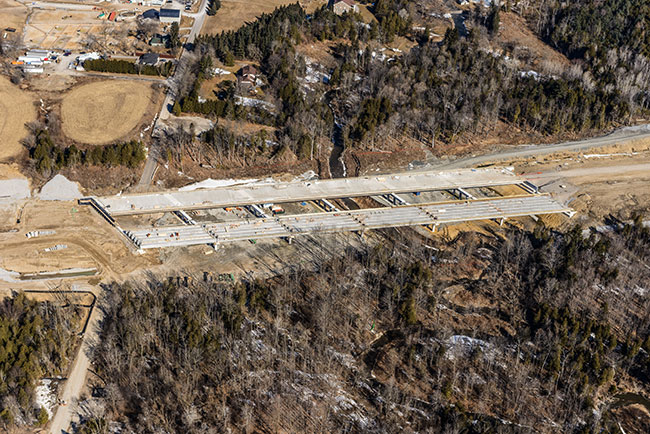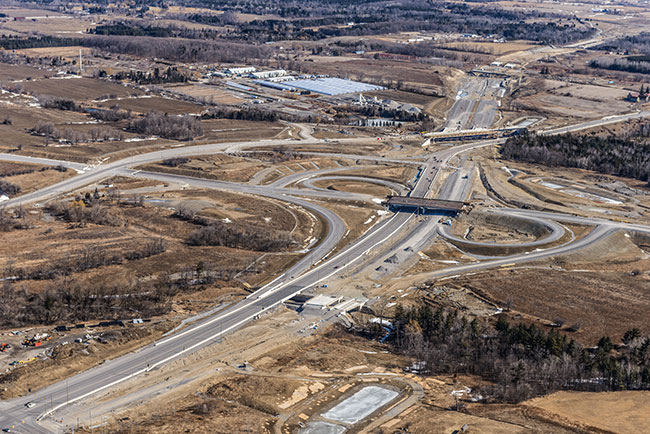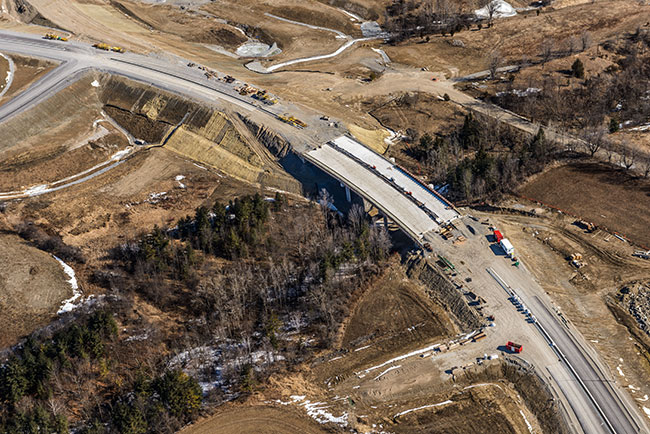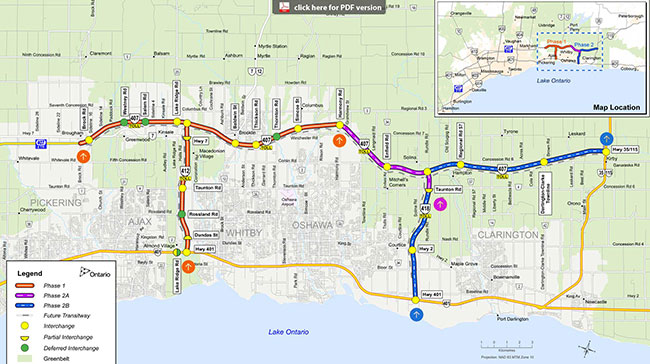
Features
Projects
Roads & Paving
Eastern Extension
Expanding the reach of Ontario’s Highway 407
May 22, 2015 By Andrew Macklin
With over six million Canadians already living within the Greater Toronto Area, and a projected growth to upwards of nine million in the next 20 years, expansion of transportation infrastructure has become vital to support the ever-increasing population.
With over six million Canadians already living within the Greater Toronto Area, and a projected growth to upwards of nine million in the next 20 years, expansion of transportation infrastructure has become vital to support the ever-increasing population.
 |
|
In the past decade, many of Toronto’s 400-series highways have been expanded, adding capacity where it is available, as well as expanding the collector/express lane systems beyond the municipal boundaries. The bulk of the work has now shifted beyond the city’s core routes, with expansion and rehabilitation happening on the highway network throughout neighbouring communities.
That expansion has led to the growth of the region’s only toll highway, Highway 407. The current length of highway, just over 100km, runs from the Hamilton/Burlington area south west of the GTA, up through the northern reaches of the region and into the east end of the city of Pickering. But with the rapid growth of the Region of Durham east through communities like Ajax, Whitby and Oshawa, which already includes rail infrastructure to support the expansion east as well as a stretch of Highway 401, it was determined that the next logical step was to also include a significant expansion of Highway 407 easterly through the Region.
The decision was made to expand Highway 407 from Pickering to Highway 35/115, north of the community of Kirby. The new construction, split into three phases (1, 2A and 2B), consists of approximately 42km of highway east to 35/115, as well as the addition of two 400-series toll highways linking Highway 401 and 407: Highway 412 (formerly known as the West Durham Link) running north from Highway 401 east of Lake Ridge Road in Whitby and Highway 418 running north from east of Oshawa.
 |
|
| A portion of the $1 billion Phase 1 expansion of Highway 407, set to be completed by the end of 2015.
|
“The planning for the project has been underway for 8-10 years,” says Calvin Curtis, the Ontario Ministry of Transportation (MTO) head of planning and engineering for the ministry’s Major Projects Office. “The environmental assessments were completed by MTO and obtained in June of 2010 provincially and federally in June of 2011. Then, in partnership with Infrastructure Ontario, the Request for Proposals (RFP) for Phase 1 went out in April of 2011 and was open until November of that year. The Preferred Proponent was selected in early 2012 and the financial closure was in May of 2012.”
That Preferred Proponent is a partnership between SNC-Lavalin and Cintra Infraestructuras’ respective subsidiaries, which is known as the 407 East Development Group. The project, being delivered using the province’s alternative financing and procurement (AFP) delivery model, is for the design, build, finance and maintain of Phase 1 at a cost of approximately $1 billion.
When the Phase 1 contract was awarded in May of 2012, the timeline for the design and build portion was scheduled at three-and-a-half years, with project completion expected by the end of 2015. That would allow construction of Phase 2A to proceed as scheduled, and the entire extension project to be finished by the end of 2020.
Phase 1 Construction
Phase 1 construction of the 407 East expansion involves three core elements:
- A 20.3km extension of the highway from Brock Road in Pickering to Harmony Road in Oshawa.
- Connecting Highway 407 to Highway 401 using the West Durham Link (Hwy. 412), a 10km, four-lane divided toll highway in Whitby.
- A 5km re-alignment of Highway 401 in order to accommodate the addition of Highway 412.
The new section involves six-lane and four-lane stretches, running six lanes to West Durham Link and four-lanes east to Harmony Road.
 |
|
| Environmental sensitivities are a large part of the expansion project. Phase 1 includes 20 conditions as outlined in the Environmental Assessment.
|
Overall, Phase 1 construction includes 148 lane kilometres of new road, 11 interchanges, 31 water crossings and 16 road crossings.
For the new highway, Infrastructure Ontario did not dictate what materials had to be used or where they had to come from. Instead, that decision was left to 407 EDG.
“From our perspective, the way these contracts are set up is that we work through the procurement phase and define what are called Performance Output Specifications,” explains Jeff Stapleton, project manager at Infrastructure Ontario. “Essentially, we say to the project group delivering the project that we want the highway to do X, Y and Z but the means and method for doing so really rests upon the consortium delivering the work. It’s up to them to select the source and deliver the materials that are used.”
Based on the specifications determined by the consortium, the closest supply of the desired aggregates were found in the small town of Brechin, which sits approximately 100km north of the construction site at the northern tip of Lake Simcoe. Four suppliers in that area are providing the aggregates for the extension project, helping culpability, supply and production rates. Two suppliers are providing asphalt, allowing 407 EDG to meet productivity and production-grade targets.
Much like the supply and specs of the aggregates used, it was also up to the consortium to determine whether the new extension would be completed using asphalt or concrete paving.
“Our design is for the roadway to be constructed with asphalt paving,” says Steven Hankins, chief executive officer of 407 EDG. “The entirety of the project is being constructed with asphalt: the West Durham Link, the extension of 407 as well as the re-aligned section of Highway 401.”
 |
|
| This map shows all three phases of the Highway 407 extension. Phase 1 is set to be completed by the end of 2015, while Phase 2A construction begins in 2016. The entire project is scheduled for completion by the end of 2020.
|
Environmental considerations
One of the biggest challenges facing the Highway 407 Phase 1 project is a series of environmental considerations that have to be addressed. The environmental assessment noted a number of sensitivities that had to be considered as part of the construction.
“Approximately 20 conditions were attached to the EA, which we had not seen [to] that extent before,” says MTO’s Curtis. “Environmental factors to consider include the Endangered Species Act requirements for this project. MTO obtained the required permits under the Act and these are a fundamental component of the contract. There are animal, bird and plant species covered under that. Then there are also multiple federal fisheries stream crossings as well.”
407 EDG environmental director Ian Upjohn recently stated, in response to questions regarding the environmental components of the contract, that: “in addition to the replacement planting of butternut and companion tree species, we have created new and restored watercourses for fish species, including the endangered Redside Dace, and will provide and enhance habitat for Barn Swallow, Bobolink and Eastern Meadowlark – all threatened bird species.”
Overall, 407 EDG plans to restore approximately 20 per cent more area than it is displacing, exceeding the requirements under the Environmental Assessment, which calls for a 1:1 replacement ratio of wetlands and forests.
Phase 1 construction, including the environmental components, is scheduled to be completed by the end of this year. 407 EDG has stated that they believe they will be able to finish in that time.
Following the completion of Phase 1, the Blackbird Infrastructure Group will take over for the construction of both portions of Phase 2 of the extension project. Phase 2 will include an additional 22 kilometres of roadway from Harmony Road in Oshawa to Highway35/115 in Clarington, as well as the construction of Highway 418 (East Durham Link). Construction of Phase 2A and 2B of the Highway 407 East expansion project are scheduled for completion by the end of 2020.
At this point, the construction has met with regional support, as municipal leaders and stakeholders understand the significance of the highway extension. That support has allowed the entire team to work together meet challenges head on, provide solution for environmental and residential considerations, and work towards building a highway that will make it easier to move both goods and people in and out of Canada’s largest city.
Print this page